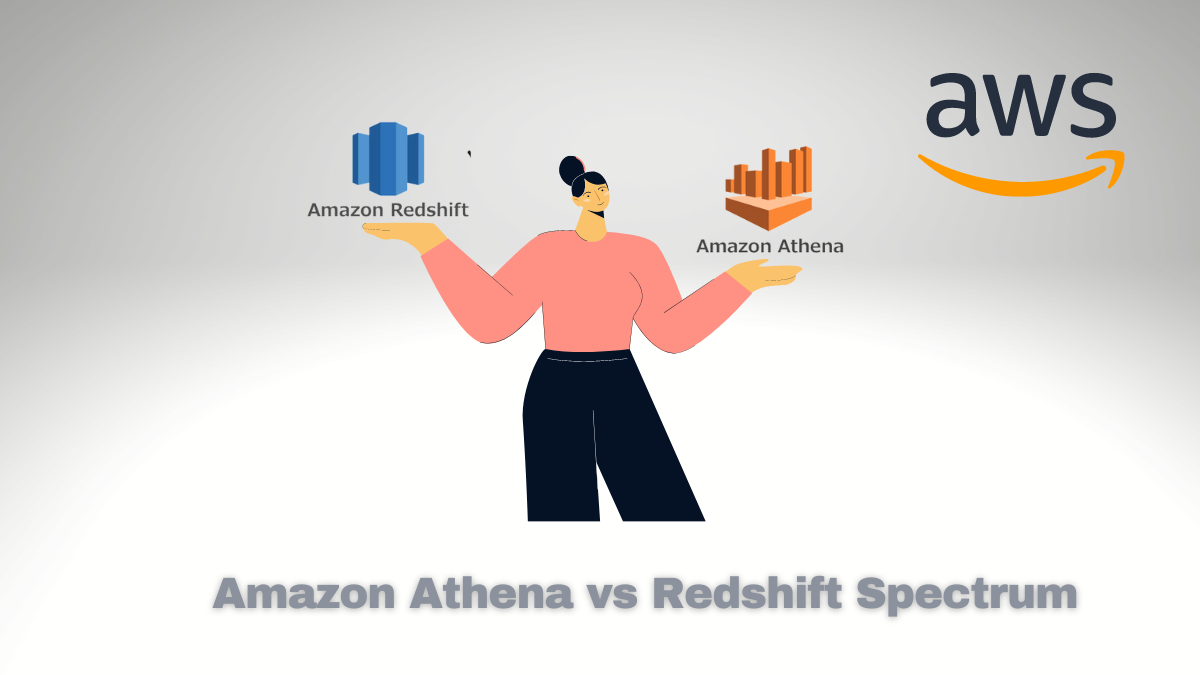Amazon Athena vs. Redshift Spectrum: Which One to Use?

The field of big data offers various tools that help process and analyze vast amounts of data. Among the popular tools within this domain are Amazon Athena and Redshift Spectrum. These tools are part of the Amazon Web Services (AWS) infrastructure and aim to aid users in querying data kept on Amazon S3. This blog post will shed more light on the differences between these two tools and identify the specific circumstances where one tool could be more advantageous.
What is Amazon Athena?
Amazon Athena is a service that allows you to quickly analyze data stored in Amazon S3 by running SQL queries. It is a serverless service, so you don’t need to worry about managing any infrastructure. You only pay for the queries that you run. Additionally, Athena supports several file formats, such as CSV, JSON, Parquet, ORC, and Avro.
Athena is easy to use because it uses standard SQL. Users don’t need to learn a new query language. Also, Athena is serverless, so there is no infrastructure to manage. This allows users to focus on their analysis without worrying about infrastructure.
What is Redshift Spectrum?
Amazon Redshift has a Redshift Spectrum feature that lets users query data on Amazon S3 using standard SQL. The SQL dialect used by Redshift Spectrum is the same as that used by Amazon Redshift, making it simple for users to begin using the tool.
Redshift Spectrum has the advantage of being integrated with Amazon Redshift. This implies that users can easily link data saved in S3 and combine it with information saved in Redshift. Moreover, Redshift Spectrum can accommodate various file formats like CSV, JSON, Parquet, ORC, and Avro.
Amazon Athena vs Redshift Spectrum
While Amazon Athena and Redshift Spectrum are designed to query data stored in Amazon S3 using standard SQL, the two tools have some key differences.
| Feature | Amazon Athena | Redshift Spectrum |
|---|---|---|
| Purpose | Serverless query service for querying data stored in S3 | Querying data stored in Redshift and S3 |
| Data Sources | S3 | Redshift and S3 |
| Query Language | SQL | SQL |
| Performance | Slower than Redshift Spectrum due to its serverless nature | Faster than Athena due to its MPP architecture |
| Cost | Pay-per-query pricing model | Pay-per-hour pricing model for Redshift cluster and pay-per-query pricing model for Spectrum |
| Integration | Integrates well with other AWS services | Integrates well with Redshift and other AWS services |
| Scaling | Automatically scales up or down based on the query volume | Can be scaled up or down manually |
| Security | Supports AWS IAM for access control | Supports AWS IAM and VPC for access control |
| Ease of Use | Easy to set up and use | Requires setting up a Redshift cluster |
| Use Cases | Best suited for ad-hoc queries and small to medium datasets | Best suited for complex queries and large datasets |
| Data Formats | Supports various data formats such as CSV, JSON, Parquet, and ORC | Supports various data formats such as CSV, JSON, Parquet, and ORC |
Infrastructure – Amazon Athena vs Redshift Spectrum
One of the key differences between Amazon Athena and Redshift Spectrum is the infrastructure required to use the tools. Amazon Athena is serverless, meaning there is no infrastructure to manage. Users only pay for the queries they run; there is no need to provision or manage any servers.
On the other hand, Redshift Spectrum is not serverless. Users must provision and manage a Redshift cluster to use Redshift Spectrum. While Redshift Spectrum can query data stored in S3, users must still manage the infrastructure required to run the queries.
Cost – Amazon Athena vs Redshift Spectrum
Another key difference between Amazon Athena and Redshift Spectrum is the cost. Amazon Athena is priced per query, meaning users only pay for the queries they run. This can be a cost-effective solution for users who only need to run occasional queries.
On the other hand, Redshift Spectrum is priced differently. Users must pay for the Redshift cluster required to run the queries and the queries themselves. This can be a more expensive solution for users who only need to run occasional queries.
Performance – Amazon Athena vs Redshift Spectrum
Performance is another critical difference between Amazon Athena and Redshift Spectrum. Amazon Athena is designed for interactive queries optimized for queries that return results quickly. This makes it a good choice for users who need to run ad hoc queries and get results quickly.
On the other hand, Redshift Spectrum is designed for complex queries that may take longer to return results. Redshift Spectrum is optimized for queries requiring complex joins or aggregations, which can take longer. This makes it a good choice for users who need to run complex queries on large datasets.
Integration – Amazon Athena vs Redshift Spectrum
Integration is another critical difference between Amazon Athena and Redshift Spectrum.
While both tools integrate with Amazon S3, Redshift Spectrum also integrates with Amazon Redshift. This means that users can quickly join data stored in S3 with data stored in Redshift, which can be helpful for organizations stored in multiple locations.
When to use Amazon Athena
Amazon Athena is a good choice for users who need to run ad hoc queries on data stored in S3. Since Athena is serverless, there is no infrastructure to manage, making it easy to start with the tool. Additionally, since Athena is optimized for interactive queries, users can get results quickly, which can be important for organizations that need to make decisions quickly.
Here are some scenarios where Amazon Athena may be a good choice:
Ad hoc analysis: Amazon Athena is a good choice for running ad hoc queries on data stored in S3. Since Athena is serverless, there is no infrastructure to manage, making it easy to start with the tool.
Quick analysis: Amazon Athena is a good choice to get results quickly. Since Athena is optimized for interactive queries, users can get results quickly, which can be important for organizations that need to make decisions quickly.
Small datasets: Amazon Athena may be a cost-effective solution if you are working with small datasets. Since users only pay for their queries, it can be a good choice for organizations that don’t need to run queries frequently.
When to use Redshift Spectrum
Redshift Spectrum is a good choice for users who run complex queries on large datasets. While Redshift Spectrum is not serverless, it is optimized for complex queries, which means it can handle queries that may take longer. Additionally, since Redshift Spectrum integrates with Redshift, it can be a good choice for organizations with data stored in multiple locations.
Here are some scenarios where Redshift Spectrum may be a good choice:
Complex analysis: Redshift Spectrum is a good choice if you need to run complex queries on large datasets. Since Spectrum is optimized for complex queries, it can handle queries that may take longer.
Big datasets: Redshift Spectrum may be a good choice if you are working with large datasets. Since Spectrum integrates with Redshift, it can join data stored in S3 with data stored in Redshift, which can be helpful for organizations with data stored in multiple locations.
Frequent queries: Redshift Spectrum may be a more cost-effective solution if you need to run queries frequently. Since users pay for the Redshift cluster required to run the queries, it can be a good choice for organizations that need to run queries frequently.
Conclusion
Amazon Athena vs Redshift Spectrum are potent tools for querying data stored in Amazon S3. While both tools use standard SQL and are designed to make it easy to analyze data, they have some key differences.
Amazon Athena is serverless, meaning there is no infrastructure to manage, and users only pay for the queries they run. Athena is optimized for interactive queries, which makes it a good choice for users who need to get results quickly.
On the other hand, Redshift Spectrum is designed for complex queries on large datasets. While Spectrum is not serverless, it is optimized for complex queries, making it a good choice for users who need to run queries that may take longer.
When deciding between Amazon Athena and Redshift Spectrum, it’s essential to consider factors such as the size of the dataset, the complexity of the queries, and the frequency of the queries. By considering these factors, users can choose the tool that best meets their needs and helps them get the insights they need from their data.




Comments